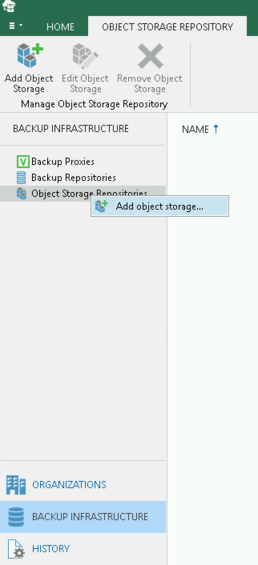- Sort Score
- Result 10 results
- Languages All
Results 1 - 10 of 28 for storage (0.15 sec)
-
docs/orchestration/README.md
MinIO is built ground up on the cloud-native premise. With features like erasure-coding, distributed and shared setup, it focuses only on storage and does it very well. While, it can be scaled by just replicating MinIO instances per tenant via an orchestration platform.
Plain Text - Registered: Sun May 05 19:28:20 GMT 2024 - Last Modified: Thu Sep 29 04:28:45 GMT 2022 - 2.2K bytes - Viewed (0) -
docs/bucket/lifecycle/README.md
To transition objects in a bucket to a destination bucket on a different cluster, applications need to specify a transition tier defined on MinIO instead of storage class while setting up the ILM lifecycle rule.
Plain Text - Registered: Sun May 05 19:28:20 GMT 2024 - Last Modified: Sat Aug 26 07:33:25 GMT 2023 - 9K bytes - Viewed (1) -
docs/integrations/veeam/README.md
- Create a new bucket for VBO backups ``` mc mb -l myminio/vbo ``` - Under Backup Infrastructure, right click on Object Storage Repositories and choose "Add object storage"  - Follow through the wizard as above for Veeam Backup and Replication as the steps are the same between both products
Plain Text - Registered: Sun May 05 19:28:20 GMT 2024 - Last Modified: Thu Sep 29 04:28:45 GMT 2022 - 5.4K bytes - Viewed (0) -
docs/config/README.md
minio server /data ``` ### Storage Class By default, parity for objects with standard storage class is set to `N/2`, and parity for objects with reduced redundancy storage class objects is set to `2`. Read more about storage class support in MinIO server [here](https://github.com/minio/minio/blob/master/docs/erasure/storage-class/README.md). ``` KEY: storage_class define object level redundancy ARGS:
Plain Text - Registered: Sun May 05 19:28:20 GMT 2024 - Last Modified: Mon Sep 11 21:48:54 GMT 2023 - 17.7K bytes - Viewed (0) -
docs/security/README.md
#### Figure 2 - KMS key hierarchy ```
Plain Text - Registered: Sun May 05 19:28:20 GMT 2024 - Last Modified: Sat Feb 12 00:51:25 GMT 2022 - 13.8K bytes - Viewed (0) -
docs/bucket/quota/README.md
- [Use `mc` with MinIO Server](https://min.io/docs/minio/linux/reference/minio-mc.html#quickstart) ## Set bucket quota configuration ### Set a hard quota of 1GB for a bucket `mybucket` on MinIO object storage ```sh mc admin bucket quota myminio/mybucket --hard 1gb ``` ### Verify the quota configured on `mybucket` on MinIO ```sh mc admin bucket quota myminio/mybucket ```
Plain Text - Registered: Sun May 05 19:28:20 GMT 2024 - Last Modified: Tue Oct 25 00:44:15 GMT 2022 - 1.1K bytes - Viewed (0) -
helm/minio/README.md
MinIO is a High Performance Object Storage released under GNU Affero General Public License v3.0. It is API compatible with Amazon S3 cloud storage service. Use MinIO to build high performance infrastructure for machine learning, analytics and application data workloads. | IMPORTANT | | -------------------------- |
Plain Text - Registered: Sun May 05 19:28:20 GMT 2024 - Last Modified: Wed Jan 24 07:27:57 GMT 2024 - 10.9K bytes - Viewed (0) -
docs/bucket/versioning/README.md
MinIO versioning is designed to keep multiple versions of an object in one bucket. For example, you could store `spark.csv` (version `ede336f2`) and `spark.csv` (version `fae684da`) in a single bucket. Versioning protects you from unintended overwrites, deletions, protect objects with retention policies.
Plain Text - Registered: Sun May 05 19:28:20 GMT 2024 - Last Modified: Thu May 04 21:43:52 GMT 2023 - 11.9K bytes - Viewed (1) -
docs/bigdata/README.md
All access to MinIO object storage is via S3/SQL SELECT API. In addition to the compute nodes, MinIO containers are also managed by Kubernetes as stateful containers with local storage (JBOD/JBOF) mapped as persistent local volumes. This architecture enables multi-tenant MinIO, allowing isolation of data between customers.
Plain Text - Registered: Sun May 05 19:28:20 GMT 2024 - Last Modified: Thu Sep 29 04:28:45 GMT 2022 - 14.7K bytes - Viewed (0) -
README.md
[](https://min.io) MinIO is a High Performance Object Storage released under GNU Affero General Public License v3.0. It is API compatible with Amazon S3 cloud storage service. Use MinIO to build high performance infrastructure for machine learning, analytics and application data workloads.
Plain Text - Registered: Sun May 05 19:28:20 GMT 2024 - Last Modified: Wed Feb 14 17:51:34 GMT 2024 - 18.7K bytes - Viewed (0)